| I-64 / I-295 Interchange Modification Project Photos - November 2007 |
This article has 42 photos that were taken in November 2007 by Roads to the Future, and in the last group, 12 photos by VDOT.
The following 17 photos were taken on November 3, 2007 by Roads to the Future. Click on the photo to get a large version of the photo. The large photos have sizes ranging from 132 to 324 kilobytes, with most of them being under 184 kilobytes. With a broadband or network Internet connection each photo will download within seconds, but with a dial-up Internet connection it will be somewhat slower.
Click to go to LATEST INFORMATION UPDATE.
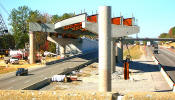 |
Steel beam placement is underway for the 2-lane flyover bridge from eastbound I-64 to eastbound I-295 (toward Washington and Norfolk). The two I-64 roadways go into the distance. Vantage point is from the I-295 overpass over I-64. In the distance is the construction of the new Pouncey Tract Road overpass. |
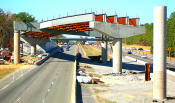 |
Steel beam placement is underway for the 2-lane flyover bridge from eastbound I-64 to eastbound I-295 (toward Washington and Norfolk). The I-64 eastbound roadway is visible to the left, and the completed construction of the piers for the flyover bridge, and the completed construction of the Mechanically Stabilized Earth (MSE) retaining walls on the earthen fill approach to the flyover bridge. Vantage point is from the I-295 overpass over I-64. |
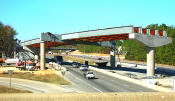 |
Steel beam placement is underway for the 2-lane flyover bridge from eastbound I-64 to eastbound I-295 (toward Washington and Norfolk). |
 |
Steel beam placement is underway for the 2-lane flyover bridge from eastbound I-64 to eastbound I-295 (toward Washington and Norfolk). Looking across the loop ramp from westbound I-295 to eastbound I-64. This is the same span as the one in the previous 3 photos. |
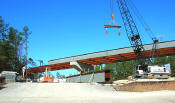 |
Steel beam placement is underway for the 2-lane flyover bridge from eastbound I-64 to eastbound I-295 (toward Washington and Norfolk). Looking across the loop ramp from westbound I-295 to eastbound I-64. |
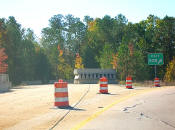 |
I-295 westbound ends a couple hundred feet ahead, with the 3-lane roadway ending at the treeline. The original plan was to extend the I-295 freeway seamlessly as the VA-288 freeway, and that is how this highway segment was constructed in 1981, with the provision for a future extension; and the western alignment of VA-288 that was approved in 1988 replaced that plan. The loop ramp from westbound I-295 to eastbound I-64 (toward Richmond) curves to the right. |
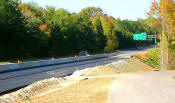 |
I-64 westbound, one half mile east of the VA-288 interchange, a third lane is being constructed on the right. The third right lane to the VA-288 interchange, begins ahead, and the current construction project ends. The third right lane will extend seamlessly between the I-295 and VA-288 interchanges. Notice the overhead sign for the exit to VA-288 southbound. Asphalt base material has been placed for the new lane. |
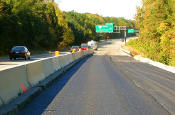 |
I-64 westbound, one half mile east of the VA-288 interchange, a third lane is being constructed on the right. The third right lane to the VA-288 interchange, begins ahead, and the current construction project ends. The third right lane will extend seamlessly between the I-295 and VA-288 interchanges. Notice the overhead sign for the exit to VA-288 southbound. Asphalt base material has been placed for the new lane and shoulder. |
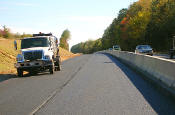 |
I-64 westbound, one half mile east of the VA-288 interchange, a third lane is being constructed on the right. Same photo spot as previous photo, but looking in the opposite direction, in the face of the traffic. |
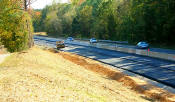 |
I-64 westbound, one mile east of the VA-288 interchange, a third lane is being constructed on the right. Asphalt base material has been placed for the new lane and shoulder. |
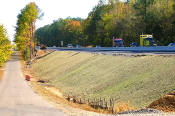 |
The westbound roadway for I-64 (toward Charlottesville) is visible, with the widening under construction to add a third lane on the outside. The road in the lower part of the photo, is a service road alongside I-64. |
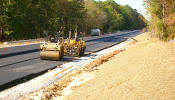 |
I-64 westbound,
one mile east of the VA-288 interchange, a third lane is being constructed
on the right. Asphalt base material has been placed
for the new lane and shoulder. An asphalt paving machine, and a drum roller
machine, is visible.
|
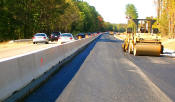 |
I-64 westbound, one mile east of the VA-288 interchange, a third lane is being constructed on the right. Asphalt base material has been placed for the new lane and shoulder. An asphalt paving machine, and a drum roller machine, is visible. |
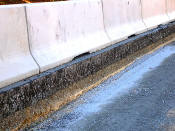 |
Edge-on
view of I-64 westbound, showing the layers of the existing roadway pavement,
exposed by the excavation for the new lane in the foreground. Aggregate base
material has been placed for the new lane.
Notice the concrete barricade that has been placed along the edge of the roadway, in order to separate the construction area from the highway traffic. The concrete barricade has the New Jersey Barrier shape, and is temporarily placed in linked segments. |
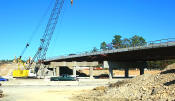 |
New VA-271 Pouncey Tract Road overpass for the northbound 2-lane portion of the bridge. It opened to traffic in the first week of October and it will carry 2-lane 2-way traffic until the southbound 2-lane portion of the bridge is constructed. |
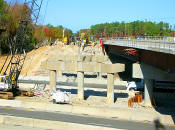 |
New VA-271 Pouncey Tract Road overpass for the northbound 2-lane portion of the bridge, to the right. The original bridge (to the left) is being dismantled, and the southbound bridge will be built in that location. |
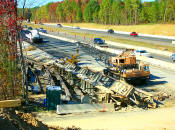 |
I-64 looking westward from near the I-64 eastbound roadway, from the VA-271 Pouncey Tract Road overpass. Two new lanes are being constructed on the left of the photo, for the approach roadway to the eastbound flyover ramp to I-295. A new mainline lane is being constructed, to widen eastbound I-64 to 3 lanes between VA-288 and I-295. The pile of steel girders in the lower part of the photo, is from the original Pouncey Tract Road overpass bridge which is is being dismantled. |
The following 18 photos were taken on November 10, 2007 by Roads to the Future. Click on the photo to get a large version of the photo. The large photos have sizes ranging from 144 to 248 kilobytes, with most of them being under 184 kilobytes. With a broadband or network Internet connection each photo will download within seconds, but with a dial-up Internet connection it will be somewhat slower.
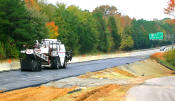 |
I-64 westbound, one half mile east of the VA-288 interchange, a third lane is being constructed on the right. The third right lane to the VA-288 interchange, begins ahead, and the current construction project ends. The third right lane will extend seamlessly between the I-295 and VA-288 interchanges. Notice the overhead sign for the exit to VA-288 southbound. Asphalt base material has been placed for the new lane and shoulder. |
 |
I-64 westbound, one mile east of the VA-288 interchange, a third lane is being constructed on the right. Asphalt base material has been placed for the new lane and shoulder. |
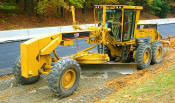 |
This and
the next 3 photos show views of a motorgrader, from the front, sides and rear.
A motorgrader is a construction vehicle with a large blade used to create a flat surface. Typical models have three axles, with the engine and cab situated above the rear axles at the rear of the vehicle and a third axle at the front end of the vehicle, with the blade in between, and with a scarifying device at the rear. In road construction, the motorgrader's purpose is to "fine grade" (refine, set precisely) the "rough grading" performed by heavier construction vehicles such as scraper pans and bulldozers, and to prepare the aggregate base course to create a wide flat surface for the asphalt or concrete pavement to be placed upon. |
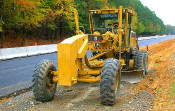 |
This motorgrader
is a Caterpillar Model 12H, see
12H Motor Grader. Not sure which exact variant this is, but the typical
12H model has a Base Power of 145 hp, a Gross Vehicle Weight of 31,320 lb,
and a Blade Width of 12 ft.
|
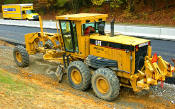 |
Caterpillar Model 12H Motor Grader |
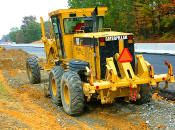 |
Caterpillar Model 12H Motor Grader |
 |
I-64 westbound, one mile east of the VA-288 interchange, a third lane is being constructed on the right. Asphalt base material has been placed for the new lane and shoulder. Notice the multiple layers of asphalt, which were placed one at a time and compacted by roller machines. |
 |
I-64 westbound, one mile east of the VA-288 interchange, a third lane is being constructed on the right. Asphalt base material has been placed for the new lane and shoulder. Notice the multiple layers of asphalt, which were placed one at a time and compacted by roller machines. The gray material under the asphalt, is aggregate base material. |
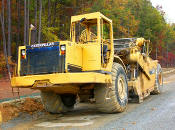 |
This and
the next 2 photos show views of a
scraper
pan (often simply called a "pan"
by construction workers), from the front, sides and rear.
A scraper pan is an earthmover device that typically can scrape up a layer of 15 cubic yards (or more depending on the size of the scraper pan) of soil and haul it to another place on the project and deposit it in a layer. Scrapers are typically used to remove earth at a work site and transport the earth over a substantial distance to another site where earth is needed or to a dump site where excess earth can be accepted. Scrapers are typically wheeled and may be towed or self-propelled. Either type of scraper includes a pan which may be lowered to be brought into contact with the earth or raised to be brought out of contact with the ground. The scraper pan contains a bin or receptacle for the holding of earth. The pan may feature an opening located near the ground surface which may be selectively opened and closed with a scraper blade incorporated into the pan near the opening. When the pan is lowered and the opening opened, the blade scrapes earth into the bin of the pan as the scraper is moved along the surface. |
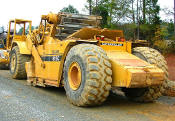 |
This scraper pan a Caterpillar Model 615C, see 615C Series II Elevating Scraper. Not sure which exact variant this is, but the typical 615C model has a Net Power of 265 hp, the Capacity Heaped is 17 cubic yards, and the Travel Speed Maximum is 27 mph. |
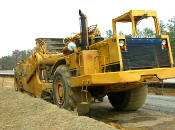 |
Caterpillar Model 615C Series II Elevating Scraper |
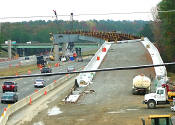 |
I-64 looking eastward, from the VA-271 Pouncey Tract Road overpass. Two new lanes are being constructed on the right, for the elevated approach roadway to the eastbound flyover ramp from I-64 to I-295 (toward Washington and Norfolk). Notice the flyover bridge piers that have been constructed, and the steel girders that have been placed on several of the spans, and the I-295 overpasses in the distance. |
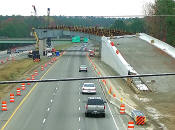 |
I-64 looking eastward, from the VA-271 Pouncey Tract Road overpass. Two new lanes are being constructed on the right, for the elevated approach roadway to the eastbound flyover ramp from I-64 to I-295 (toward Washington and Norfolk). Notice the Mechanically Stabilized Earth (MSE) retaining walls constructed on the earthen fill approach to the flyover bridge. Notice the flyover bridge piers that have been constructed, and the steel girders that have been placed on several of the spans, and the I-295 overpasses in the distance. |
 |
I-64 looking eastward, from the VA-271 Pouncey Tract Road overpass. Notice the Mechanically Stabilized Earth (MSE) retaining walls constructed on the earthen fill approach to the flyover bridge. Notice the flyover bridge piers that have been constructed, and the steel girders that have been placed on several of the spans, and the I-295 overpasses in the distance. |
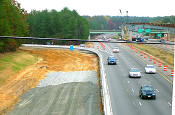 |
I-64 looking eastward over the westbound roadway, from the VA-271 Pouncey Tract Road overpass. The ramp from westbound I-295 to westbound I-64 (toward Charlottesville), enters I-64 from the left side of the photo. This one-lane ramp is being widened to two lanes, and is being relocated in two places to provide a higher-speed alignment. The wide graded area to the left is one of the places where a ramp curve will be lessened. |
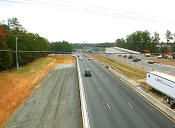 |
I-64 looking eastward over the westbound roadway, from the VA-271 Pouncey Tract Road overpass. Same vantage point as previous photo, wide angle view. |
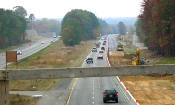 |
I-64 looking westward from over the I-64 westbound roadway, from the VA-271 Pouncey Tract Road overpass. A new lane is being constructed on the right, to widen westbound I-64 to 3 lanes between I-295 and VA-288. |
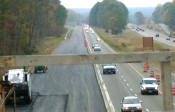 |
I-64 looking westward from over the I-64 eastbound roadway, from the VA-271 Pouncey Tract Road overpass. Two new lanes are being constructed on the left of the photo, for the approach roadway to the eastbound flyover ramp to I-295. A new mainline lane is being constructed, to widen eastbound I-64 to 3 lanes between VA-288 and I-295. Asphalt base material has been placed for the new lanes and shoulder. |
The following 7 photos were taken on November 18, 2007 by Roads to the Future. Click on the photo to get a large version of the photo. The large photos have sizes ranging from 144 to 184 kilobytes, with most of them being under 176 kilobytes. With a broadband or network Internet connection each photo will download within seconds, but with a dial-up Internet connection it will be somewhat slower.
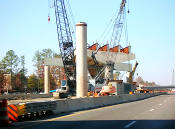 |
I-64 westbound, with the eastbound flyover construction
visible in the center of the photo.
Notice the concrete barricade that has been placed along the edge of the roadway, in order to separate the construction area from the highway traffic. The concrete barricade has the New Jersey Barrier shape, and is temporarily placed in linked segments. |
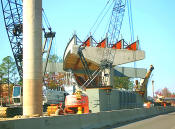 |
I-64 westbound, with the eastbound flyover construction visible in the center of the photo. |
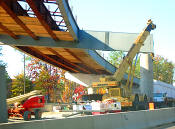 |
I-64 westbound, with the eastbound flyover construction visible in the center of the photo. |
 |
I-64 eastbound, approaching the VA-271 Pouncey Tract Road overpass, two new lanes will be constructed on the right, for the roadway to the eastbound flyover ramp to I-295. The northbound 2-lane portion of the VA-271 new bridge opened to traffic in the first week of October and it will carry 2-lane 2-way traffic until the southbound 2-lane portion of the bridge is constructed. The original 2-lane bridge is being dismantled, and the southbound 2-lane portion of the new bridge will be constructed on nearly the same location as the original bridge. |
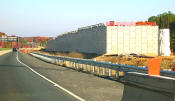 |
View from the I-295 temporary roadway for the interchange ramp movement from eastbound I-64 to eastbound I-295 (toward Washington and Norfolk). The temporary roadway is needed to remove traffic from a section of the eastbound I-295 roadway so that it can be rebuilt with an elevated approach for the new flyover ramp. Ahead is the construction of the Mechanically Stabilized Earth (MSE) retaining walls on the earthen fill approach from the flyover bridge for the new semi-directional ramp from eastbound I-64 to eastbound I-295 (toward Washington and Norfolk). This is the "landing" for the flyover ramp on I-295. This and the next 2 photos are in the same driving sequence. |
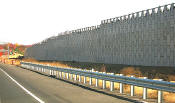 |
View from the I-295 temporary roadway for the interchange ramp movement from eastbound I-64 to eastbound I-295 (toward Washington and Norfolk). Ahead is the construction of the Mechanically Stabilized Earth (MSE) retaining walls on the earthen fill approach from the flyover bridge. |
 |
View from the I-295 temporary roadway for the interchange ramp movement from eastbound I-64 to eastbound I-295 (toward Washington and Norfolk). Ahead is the construction of the Mechanically Stabilized Earth (MSE) retaining walls on the earthen fill approach from the flyover bridge. |
**LATEST INFORMATION UPDATE follows**
The following 17 photos were taken on November 27, 2007 by the Virginia Department of Transportation, and are posted here with their permission. Roads to the Future utilized PhotoDeluxe Business Edition to sharpen and brighten and to align all of the photos. Click on the photo to get a large version of the photo. In later versions of Netscape and Internet Explorer, you probably will need to use Full Screen mode (the F11 key can be utilized to swap back and forth between Full Screen and Regular) to see the full size of the large photo without browser-induced image shrinkage. The large photos have sizes ranging from 193 to 349 kilobytes, with most of them being under 207 kilobytes. With a broadband or network Internet connection each photo will download within seconds, but with a dial-up Internet connection it will be somewhat slower.
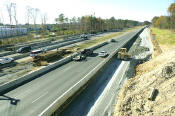 |
I-64 looking westward from across the I-64 westbound roadway, from the VA-271 Pouncey Tract Road overpass. A new lane is being constructed on the right, to widen westbound I-64 to 3 lanes between I-295 and VA-288. Aggregate base material is being placed for the new lane. |
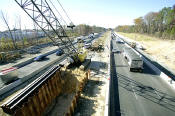 |
I-64 looking westward from over the I-64 median, from the VA-271 Pouncey Tract Road overpass. The excavation with sheet pile in the lower left of the photo, is for the center pier of the new 2-lane southbound VA-271 Pouncey Tract Road overpass. Notice the H-piles stacked just to the left of the excavation. |
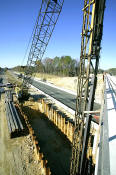 |
I-64 looking westward from over the I-64 median, from the VA-271 Pouncey Tract Road overpass. The excavation with sheet pile in the lower part of the photo, is for the center pier of the new 2-lane southbound VA-271 Pouncey Tract Road overpass. Notice the H-piles stacked just to the left of the excavation. In the right of the photo, a crane is driving a pile into the ground; a series of driven piles will be the foundation for a concrete footer that will support the bridge piers. |
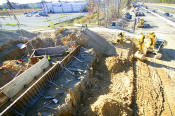 |
I-64 looking westward from beside the the I-64 eastbound roadway median, from the VA-271 Pouncey Tract Road overpass. The wooden forms in the lower left, are for the concrete pour to construct the footer for the south abutment (terminal structure) for the new 2-lane southbound VA-271 Pouncey Tract Road overpass. |
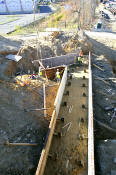 |
I-64 looking westward from beside the the I-64 eastbound roadway median, from the VA-271 Pouncey Tract Road overpass. The wooden forms in the lower part of the photo, are for the concrete pour to construct the footer for the south abutment (terminal structure) for the new 2-lane southbound VA-271 Pouncey Tract Road overpass. Notice the tops of the H-piles visible above ground level in the forms - the series of driven piles will be the foundation for the concrete footer that will support the abutment. |
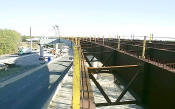 |
Steel beam girder placement for the 2-lane flyover bridge from eastbound I-64 to eastbound I-295 (toward Washington and Norfolk). The reinforced concrete roadway deck will be constructed across the tops of the steel girders. |
 |
Steel beam girder placement for the 2-lane flyover bridge from eastbound I-64 to eastbound I-295 (toward Washington and Norfolk). The reinforced concrete roadway deck will be constructed across the tops of the steel girders. Notice how the steel beams are horizontally curved to match the curve of the flyover bridge, which will be designed for 60 mph travel.. |
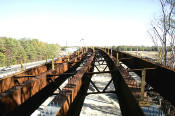 |
Steel beam girder placement for the 2-lane flyover bridge from eastbound I-64 to eastbound I-295 (toward Washington and Norfolk). The reinforced concrete roadway deck will be constructed across the tops of the steel girders. |
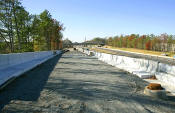 |
I-64 looking westward, from the top of the elevated approach roadway to the eastbound flyover ramp from I-64 to I-295 (toward Washington and Norfolk). This is looking in the reverse direction of the future flyover traffic, from the reverse direction of the previous photo's vantage pount. |
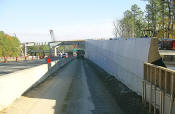 |
I-64 looking eastward, from the right shoulder of the I-64 eastbound roadway. Two new lanes are being constructed on the right, for the elevated approach roadway to the eastbound flyover ramp from I-64 to I-295 (toward Washington and Norfolk). Notice the Mechanically Stabilized Earth (MSE) retaining walls constructed on the earthen fill approach to the flyover bridge. Notice the flyover bridge spans in the distance. |
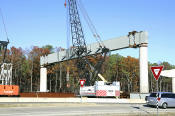 |
Pier construction for the 2-lane flyover bridge from eastbound I-64 to eastbound I-295 (toward Washington and Norfolk). This pier structure is called a 'straddle bent', which is a pier that spans ("straddles") a roadway because a conventional pier would plant a pier in the middle of the roadway. |
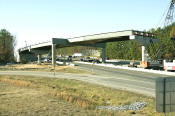 |
Steel beam placement for the 2-lane flyover bridge from eastbound I-64 to eastbound I-295 (toward Washington and Norfolk). The middle pier structure is a straddle bent. Looking across the loop ramp from westbound I-295 to eastbound I-64. |
Lead article - I-64 / I-295 Interchange Modification Project
Roads to the Future photos by Scott Kozel.
This article was released on January 1, 2008, with the 17 photos of November 3, 2007, the 18 photos of November 10, 2007, and the 7 photos of November 18, 2007. The 12 photos of November 27, 2007, were added on January 14, 2008.
Copyright © 2008 by Scott Kozel. All rights reserved. Reproduction, reuse, or distribution without permission is prohibited.
By Scott M. Kozel,
Roads to the Future(Created 1-1-2008, last updated 1-14-2008)
